Getting Started
Welcome to all newcomers to O Gauge
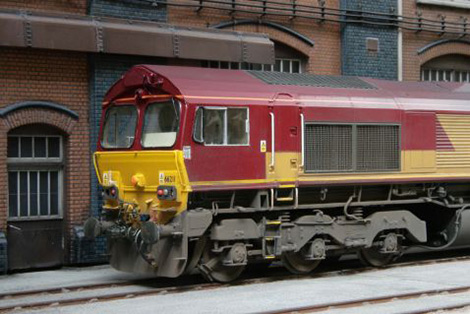 Class 66 by Brian Daniels.
Class 66 by Brian Daniels.
This page has some suggestions about starting in O Gauge finescale. It covers what is available in locos, coaches, wagons and track to get you going quickly.
A word of caution: there is not a single standard for wheels and track in O Gauge. The suggestions made on this page relate to finescale. There is also coarse scale (also known as standard scale)
for which a few manufacturers provide some models, but these are not compatible with fine scale trackwork.
It is worth remembering that for a given room space you need less O Gauge stock than you would need in the smaller scales.
So while O Gauge at first sight may seem to be more expensive per item, the fact that you need less stock makes the overall cost about the same.
The larger size gives the models more presence.
For the quickest way to a working layout, you can buy ready to run (RTR) locos, wagons and coaches either new
or secondhand. As well and the growing number of RTR items from the trade, the Guild website provides a sales page where members
can advertise items for sale and also place requests for items they are looking for. There is always a Bring & Buy stand at Guild shows.
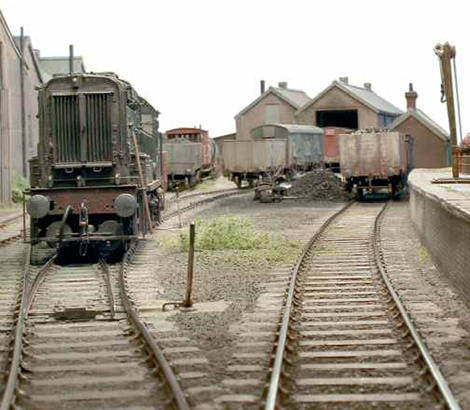 A scene from 'Napier Street' by Nigel Bowyer showing
A scene from 'Napier Street' by Nigel Bowyer showing
the intimate detail possible in 7mm scale.
There are specialists who can build your baseboards or provide laser cut kits, lay track and provide scenery - all at a cost of course. Alternatively you can make your own models.
The following sections try to suggest what to look for in selecting the different items you need for a layout.
The Guild has published three volumes of small layout plans. Volumes 2 & 3 are still available from the Guild's on line shop
For the lowest cost outlay, you could consider scratch building. The larger scale makes it much easier to make quality items, both in rolling stock and buildings.
However, you may prefer to take that step later, but there are numerous suppliers of materials and component castings if and when you decide to take that step.
Track
Finding good track is one of the easy bits.
There are a couple of manufacturers of track ready made in flexible yard lengths, such as Peco and Marcway. Left and right hand, Y points and double slips suffice for most track layouts.
More advanced layouts can be made by making your own track using readily available components from Exactoscale, C&L or Permaway, easily glued together.
For more complex track arrangements such as single slips or crossovers, MarcWay offer a custom build service at reasonable prices.
For details of the various track standards associated with O gauge, please see the What is O gauge? page.
Locomotives
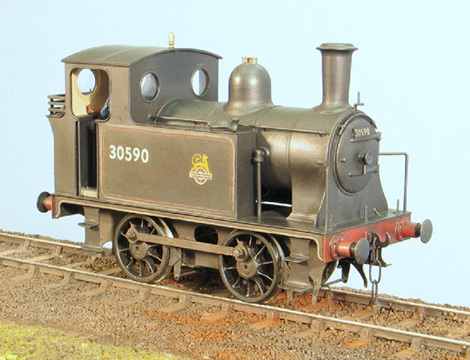 An example of a simple etched loco kit from Connoisseur Models.
An example of a simple etched loco kit from Connoisseur Models.
There are now several manufacturers making RTR locomotives, notably Heljan, Dapol (and its sister brand Lionheart) and Minerva, with more to come.
More expensive, there are now many brass RTR engines built in the Far East to a very high standard. Several of the kit manufacturers also offer their kits built and ready to run.
You only need to scan the adverts in the Guild's Gazette to find them.
Buying a high quality ready built engine from one of these sources can inspire you to build your own. It gives you a standard to aim for.
Most people move into O Gauge because they want more detail in the stock they own.
This is achieved by building your own locos from kits, or by adding detail to some of the RTR items. Some small traders offer sets of details to enhance the already excellent RTR offerings.
If you are going to try building from a kit choose something simple to start with.
If it is a steam outline engine, then choose a simple tank engine first, with main drivers only, and no outside valve gear.
Connoiseur have recently reintroduced their 0-4-0T starter kit, which is a very simple engine to start on.
Once practised, soldering etched parts is not difficult, but it is a skill which needs to be learnt and this takes time. This video on the Guild's YouTube channel
will certainly help you. Alternatively find someone who knows already, and learn from them. It is so much quicker than using trial and error.
The best way is to join one of the model railway clubs with an O Gauge section or one of the many O Gauge groups. Many of these are listed on the Club Details page on this website.
Wagons
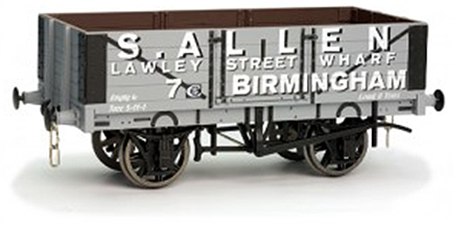 A Dapol ready to run wagon.
A Dapol ready to run wagon.
RTR wagons are increasingly being offered. Dapol (and Lionheart), Minerva and Heljan offer a wide range at very reasonable prices. Again, look for second hand wagons already built.
There is an excellent range of plastic kit wagons from manufacturers such as Slaters and Parkside by Peco. They are easy to assemble and paint, and look very good when complete.
They come with all required parts so there is no need to trawl the shops and trade for extras like wheels, couplings and buffers.
There is also a massive variety of etched brass kits for wagons from many periods and railways.
Coaches
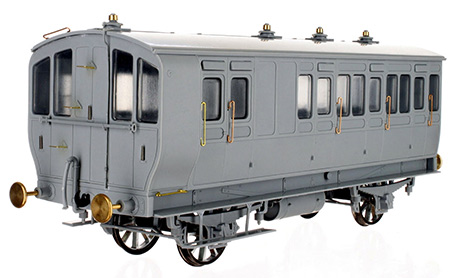 Forthcoming Dapol LBSCR 4 wheel coach
Forthcoming Dapol LBSCR 4 wheel coach
There has been an increase in the number of ready to run coaches available though almost all are of post nationalisation prototypes. Heljan BR Mk1s were introduced some time ago,
but more recently both Darstaed and Dapol (via their Lionheart brand) have intruced a number of Mk1 variants, including non-gangwayed stock.
Heljan have recently announced Mk2s while Dapol have announced a range of short 4-wheel LBSCR coaches which will suit those with limited space or are building period or light railway based layouts.
There are some plastic coach kits available from Slaters but the bogie ones are more complex to assemble than the wagons. There are cast resin kits from MM1 Models, again largely BR types.
Ian Kirk produces modular components to build a wide variey of coaches from the Big Four era which will build into very acceptable models for very modest cost.
There is a much wider range of largely etched brass kits, but some skill is needed to build and complete these kits. Over 1300 different coach kits are listed in the Guild's product directory.
Buildings and Structures
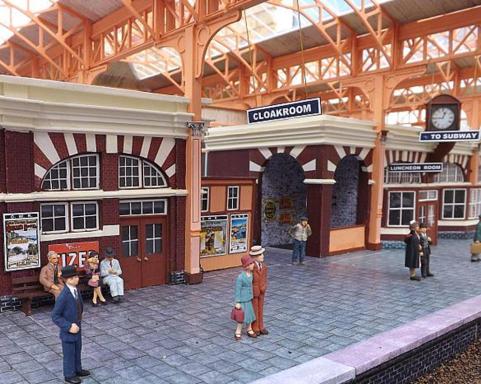 Birmingham Snow Hill by Peter Smith
Birmingham Snow Hill by Peter Smith
The increasing popularity of laser cutting has led to an explosion in the number of kits available for buildings and structures.
These are generally quite straightforward to assemble and the difference in a good and merely average model is often down to how well it is painted.
A chance for your artistic skills to shine.
Electrical
Most O gauge locos are powered by electric motors driving the wheels and work with the normal 12 volt DC system,
although sometimes higher voltages are used. If you are buying second hand stock check that the voltage is as expected.
Usually because O gauge engines and stock are heavier than OO gauge stock the current drawn is higher and therefore
heavier duty controllers need to be used.
If you are starting in O gauge then it is recommended that the DCC
system is considered (DCC stands for Digital Command Control). There is a higher initial cost involved, but the
benefit is much simpler layout wiring, control of all engines simultaneously, control of points from the same
hand held controller, and the ability to fit sound to the stock. Having sound transforms the enjoyment of the layout enormously.
Summary
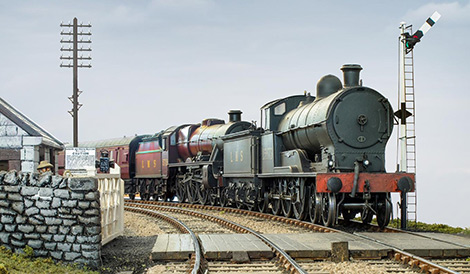 Scout green crossing by Paul Scott
Scout green crossing by Paul Scott
The best advice is to start small. Decide first on what you would like to model, be it pre-grouping, post grouping, nationalised, industrial or
a light railway. Choose simple prototypes first. It may be wonderful to have a express 4-6-2 pulling 10 pullman coaches, but consider whether
you would ever complete the stock.
Build the skills slowly; visit the Gauge O Guild shows and talk to the demonstrators.
They have great advice to impart. If you can, join a club and ask for advice. When you think you want to buy a kit, open
the box before you buy and inspect all the parts. If it all looks too much work then it probably is, and maybe you'll never finish it.
Say your apologies and tell the seller that you'll buy one when your skills have improved!
But most of all, persevere. There is nothing more satisfying than finishing a model to the best of your ability, placing it on a layout
and admiring it. For the next model, consider how you would make it better.
Be inspired by what others do and use their standards as something to aim for. Buy the best tools.
They are worth their weight in gold. Enjoy what you do; it's a hobby after all.